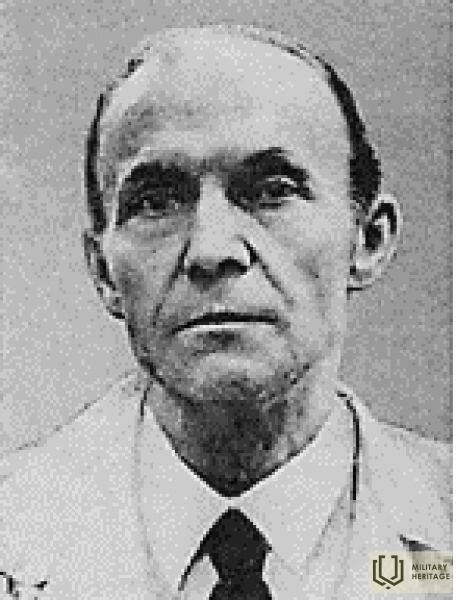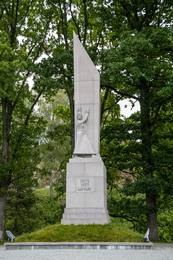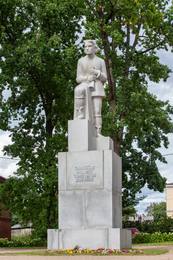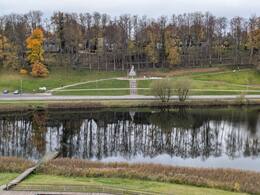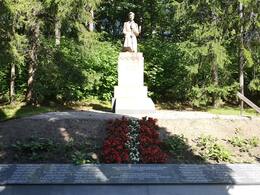Sculptor Kārlis Zemdega (1894-1963)
II World War II, IV Soviet Occupation
Kārlis Zemdega (until 1935 – Kārlis Baumanis) was born on April 7, 1894 in Cīrava parish.
He studied at Cīrava parish school and Dunalka elementary school. He graduated from Aizpute city school. He continued his education in Riga at the Blums Drawing School and the Art Academy, where he studied both sculpture and drawing.
In 1927, he graduated from the Sculpture Workshop under the direction of Konstantin Rončevski with the work "Jacob's Fight with the Angel". After that, he continued to work at the Applied Sculpture Workshop, where he mastered the technical techniques of stone processing. Since he had financial difficulties, he had to earn money for his studies by working as a civil servant and a drawing teacher. He worked as a teacher at the Academy of Arts - head of the Sculpture Workshop (1940 - 1941), professor (1947 - 1962) and in parallel worked on orders.
Kārlis Zemdega created the Rainis gravestone at Rainis Cemetery in Riga (1935) and is the author of the design of the Rainis monument in Riga, Esplanade (materially implemented by sculptors Laimonis Blumbergs and Aivars Gulbis in 1965). He is the author of several memorial monuments dedicated to those who fell in World War I and the victims of the battles of the War of Independence - "Koklētāja" in Rauna (1933), Viļaka (1935), to those who fell in World War I in Džūkste (1935), "Tālavas tauretājs" in Rūjiena (1937), Dobele Liberation Monument (1939), "Koklētājs" in Talsi (created by Vilnis Titāns in 1996 according to Kārlis Zemdega's plan). The monument "The Sower" in Rūjiena is dedicated to the former Prime Minister of Latvia Arturs Alberings (1876–1934). Zemdega's work is mostly monumental, but his oeuvre also includes several significant portraits and figurative works.
Kārlis Zemdega died on November 9, 1963 in Riga and was buried in the Rainis Cemetery.
A memorial stone was erected in 1975 at the former "Gaiļi" residence in Cīrava parish, where the sculptor was born.
More information sources
People related to Aizpute and the region. Biographical dictionary: http://vardnica.aizpute.lv/33-personas-z/670-zemdega-karlis
Vija Gune. I want big light blue wings: a version about Kārlis Zemdega. Riga: Zvaigzne ABC, 1995.
Kārlis Zemdega. "And I will rise strong..." Concept and arrangement by Ingrīda Burāne. Riga: Zinātne, 2019.
Related objects
Freedom Monument in Rauna
The monument, created by sculptor Kārlis Zemdegs, is dedicated to the memory of the members of the Rauna parish who fell in World War I and the War of Independence.
As one of the unrealized variants of the Riga Freedom Monument project, it was unveiled on August 20, 1933. The 3rd President of the Republic of Latvia, Alberts Kviesis, attended the opening event.
The original name of the monument was "ES DŪR" - the motto - the spear turns into a kokle and the people are saved by the spirit of song. The base of the monument is decorated with the words of the hymn composed by Baumaņi Kārlis - "God, bless Latvia".
Before the monument was unveiled in 1933, the people of Raunė, while carrying out landscaping work around the monument, planted an oak alley and placed a capsule with the name of a fallen soldier under each oak tree. Later, in 1937, the names of the fighters were engraved on a white marble slab, which is placed in the church.
During the communist occupation, the inscription "God, bless Latvia" was removed from the pedestal. It was restored when the Revival began in June 1989.
Monument “Tālavas taurētājs”
Located in Rūjiena Center Square.
The three-meter-high image of an ancient Latvian guard soldier, carved from gray Finnish granite, called the “Tālavas trumpeter”, is placed on a three-meter-high granite pedestal, but the total height of the monument reaches 7.5 meters. In the initial sketches and models, K. Zemdega had placed a sword in the warrior’s hands, which was later replaced with a trumpet. The monument was unveiled on August 15, 1937.
This monument reflects the difficult situation in the formation of our state and army, as well as the assessment of these events. Immediately after the proclamation of the Latvian state, the Red Army invasion began and the provisional government of Kārlis Ulmanis found refuge in Liepāja. In February 1919, with the help of the Estonian army, the liberation of Latvia from the north began and the first mobilizations of the Latvian troops being formed in Tērbatas took place in the Rūjiena area, which, under the command of Colonel Jorģis Zemitāns, became the North Latvian Brigade. The North Latvian Brigade fought not only against the Bolsheviks, but also against the Landeswehr and the Iron Division in the battles of Cēsis. The North Latvian soldiers mobilized in the Rūjiena area also fought in subsequent battles of the War of Independence. After the war, the main laurels of victory went to General Jānis Balodis and the South Latvian Brigade commanded by him, but the North Latvian Brigade was often forgotten. The planned monument to the North Latvian Brigade in Rūjiena also took a long time to be created, and the monument, unveiled in 1937, was officially promoted as a monument to the liberation of the Rūjiena region and in memory of the fallen soldiers, without mentioning that all the regiments that were part of the North Latvian Brigade had their beginnings in Rūjiena.
The monument is not only a popular tourist attraction for Latvian and Estonian tourists, which is to some extent a starting point for visiting several other War of Independence memorial sites in Rūjiena, but the "Tālavas tauretājs" is also a stopping point for visits by Estonian and Latvian state and local government officials of various levels.
The Rūjiena Liberation and Fallen Soldiers Monument, more commonly known as the "Tālavas tauretājs" (Far-away Horner), was included in the list of state-protected cultural monuments on October 29, 1998 as an art monument of national importance (monument protection registration number 4522).
Monument "Koklētājs" (Fiddler)
The monument "Koklētājs" in Talsi on Ķēniņkalns is dedicated to the memory of the Freedom Fighters (authors K. Zemdega, sculptor V. Titans).At the end of the 1930s the Talsi City Council commissioned sculptor K. Zemdega (1894-1963) to make the monument. In 1938, the sculptor made a plaster model of the sculpture and a capsule with a message for future generations about the history of the creation of the monument was buried in the Leči hill. The Second World War put an end to this idea, but the cast was hidden and preserved. With the restoration of independence, the idea of completing the monument was revived. V. Titans begins to carve the "Koklētājs" in stone at the Museum of Agricultural Technology "Kalēji". The monument was inaugurated on 16 November 1996, and the ceremony was also attended by the then President of Latvia, G. Ulmanis.
Monument of K. Zemdega to the Victims of the World War I in Tukums
Located in Tukums, at the foot of Saules Hill.
The monument "The Rifleman" designed by Kārlis Zemdega is one of the last monuments to be unveiled in 1940 before Latvia lost its independence. It depicts a young soldier kneeling and swearing allegiance to his Fatherland. At the foot of the monument is the Brothers' Cemetery with more than 40 burials.
During World War I, when Kurzeme was under German occupation, a cemetery was established on the slope of Pavārkalns. People who were shot and sentenced to death by the German military court were buried there. Initially, the burials were numbered and only in 1925 was it possible to determine the identities of all the sentenced people. They were mainly captured Latvian riflemen. Among them were also civilians. Later, the remains of the people were reburied together with the fallen Latvian army soldiers in the place where the Brothers' Graves were created at the foot of the K. Zemdega monument.
Today, you can visit the memorial site. K. Zemdega created several excellent monuments, including the one in Tukums.
Monument to the sons of Dzukste and Slampe congregations killed in World War I and Latvian Liberation Battle
Monument to the sons of Dzukste and Slampe congregations killed in World War I and Latvian Liberation Battles was unveiled on November 17, 1935. The author is one of the best Latvian sculptors - Karl Zemdega.
Monument to the soldiers who fell in the Latvian liberation struggle in Yaškovo
Located on the left side of the Viļaka – Vientuļi road section (P35), near the Jaškova cemetery chapel.
Monument to the Latvian and Estonian soldiers who fell in the War of Independence.
The monument, created by sculptor Kārlis Zemdega in memory of the soldiers who fell in the 1920 Liberation War in Jaškovo, was first unveiled on September 22, 1935, at the Viļaka Brothers Cemetery, established in 1929.
The freedom struggle against the Red Army in the Viļaka region began with the attack of the Latvian Army and the Latgale Partisan Regiment on January 9, 1920. Estonian soldiers also participated in it. Viļaka was liberated on January 9, but the fighting to the east of it continued for several more days. Both before and after the liberation of Viļaka, the fallen soldiers were buried in various places known to the local population. As the Latvian state stabilized, people began to think about arranging a common fraternal cemetery in Viļaka. Already on November 18, 1923, after a solemn service in the Catholic church, held by Dean P. Apšinīks, a large procession went to the newly created fraternal cemetery on a hill, in the so-called Jaškovs - in the immediate vicinity of Viļaka. Soon the foundations of the monument were built, and donations for the monument began to be collected. The identification of the graves of the fallen soldiers took time, and only on November 3, 1929, the reburial in the future fraternal cemetery took place. 31 Latvian and 14 Estonian soldiers who fell in the Viļaka area were buried there. In 1935, the monument was ready and it was solemnly consecrated on September 22.
During the pre-war years of Latvian independence, all important national events in Viļaka parish were associated with the fraternal graves and this monument.
The monument was destroyed during the post-war years of Soviet rule, but its granite parts, although damaged, were preserved. The monument was restored on November 11, 1990 - Lāčplēsis Day.
Related stories
Rauna Freedom Monument or Monument to the memory of the members of the Rauna parish who fell in the First World War and the Freedom Struggles
The origins of the idea for the Rauna Freedom Monument can be traced back to August 21, 1929, when the mayor of Cēsis and the head of Cēsis district invited the most prominent public figures of Rauna parish to a meeting, inviting them to honor the achievement of freedom and build a monument in Rauna.




